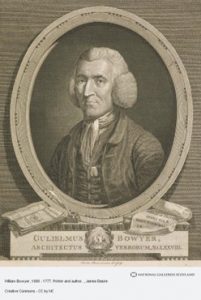Table of contents
- Introduction
- Printers
- Methods & Materials
- Case Studies
- Visualisations
- Reflection
- Conclusion
- Division of Labour and Reflection on Learning
- References
Printers
Our initial research focus was on the decorative initials of London printers Richardson and Bowyer, but while examining Bowyer’s initials, we became interested in the connections between printing in London and Dublin. This was an iterative process – we were led by finding similarities between DIs used in books printed in London and those printed in Dublin. The striking resemblance of the DIs in question made it possible for our models and the mechanism behind the Compositor’s visual search tool to detect and group together similar DIs. The massive amount of data would have been impossible to go through manually. The following is a summary of the four printers relevant to our research.
London printers
Samuel Richardson
Samuel Richardson (d. 1761) was a London-based printer and author (Dussinger, 2012). He is thought to have been an active printer for over 40 years, at least from 1720 to 1761. During this time, he served a wide range of customers and is believed to have printed almost 500 works. These works include newspapers and books, as well as parliamentary bills and papers (Maslen, 2001).

As Samuel Richardson was an active figure in the 18th century London’s book printing business, we used his ornaments as one of the starting points to detect connections between the books found in the ECCO dataset. Keith Maslen listed in his book “Samuel Richardson of London, Printer: A Study of his Printing Based on Ornament Use and Business Accounts” (2001) 526 ornaments used by Samuel Richardson. Of those, 15 are decorative initials, one of which had a match in our dataset. The resulting case study will be presented later in this blog.
The Bowyer Ledgers
William Bowyer the elder started keeping records in The Bowyer Ledgers in 1710, eleven years after establishing himself as a master. In 1713, a fire destroyed the printing-house and burned equipment, edition sheets held for clients and earlier records, causing a short break in the record. The press that arose from the ashes was led by William Bowyer senior until his death in December 1737. He had been joined by his Cambridge-educated son, William, as a corrector of the press in 1722. The father may have hoped to establish an English printing family dynasty. The younger Bowyer took over The Bowyer Ledgers and maintained them until his death in 1777 (Maslen, 1988, pp. 143–144).

As Bowyer was another prominent figure along with Richardson in the 18th century London printing business, his decorated initials were also used as a starting point for our research. Maslen’s book contains 84 of Bowyer’s DIs which we then compared to the DIs of our dataset. The result of this approach can be found in our analysis under the part “Bowyer and Dublin”.
Dublin printers
George Grierson
George Grierson (1680–1753) was a Scottish-born printer and publisher in Dublin, Ireland. His descendants continued in the book trade in Dublin for several generations. He was married to the editor and poet Constantia Grierson. From 1732 to 1753, operating under the title ‘King’s Printer in Dublin, Grierson was the only printer in Dublin allowed to print Holy Bibles. Later his attention turned towards cartography. His publishing output was “large by Dublin standards” and the quality of his printing was “consistently good” (Woods, 2009).
Oliver Nelson
Oliver Nelson (1715–1775) was an Irish printer, who was apprenticed to George Grierson on Essex Street in Dublin from 1736 onward. Before this he likely worked intermittently for William Bowyer in London between 1732–1736, but his early life remains unknown. He set up permanently in Miller’s Head, Skinner’s Row and began a successful career publishing extensively. He was accused of piracy by George Faulkner (Irish printer, 1699-1775) over an edition of Lord Orrery’s Remarks on the life of Swift (1751) and by Robert Main over Eliza Heywood’s History of Miss Betsey Thoughtless (1751). He took over the Dublin Courant from September 1745 to February 1752 transforming it into the leading paper for booksellers and replacing the Dublin Weekly Journal (Hourican, 2009).
